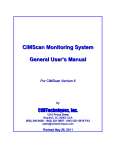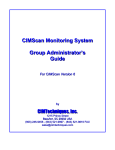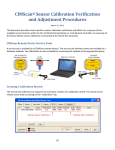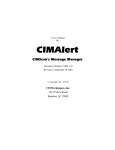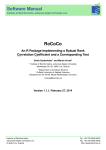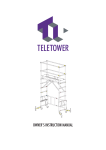Download CIMScan User`s Manual
Transcript
CIMScan Monitoring System System Administrator’s Guide For CIMScan Version 6 by CIMTechniques, Inc. 1215 Prince Street Beaufort, SC 29902 USA (800) 246-9456 - (843) 521-9897 - (843) 521-9818 FAX [email protected] Revised May 18, 2011 CIMScan Overview CIMScan is an incredibly easy to configure and use real-time monitoring system. It is typically used to alert users to abnormal conditions that have been detected where critical materials are stored or processed. While the system is normally used to monitor temperatures, it can be used for anything for which a sensor is available. This manual contains information specifically for System Administrators and should be used in conjunction with the CIMScan User’s Manual and the Group Administrator’s Guide. Table of Contents Editing the System Settings...............................................................................................3 Configuring the User Roles................................................................................................5 Adding New Groups...........................................................................................................7 Creating New Group Administrators................................................................................10 Selecting User’s Groups.................................................................................................. 15 2 Editing the System Settings The system-wide settings can be accessed by clicking on “System Settings” in the “Admin/System Admin” menu. This will display the page shown below. These settings apply to the entire system. The following section describes each setting in detail. System Name..........................This is the name that appears in the heading of the reports. Password Expiration...............Passwords automatically expire in this number of days. Session Timeout......................Users are automatically logged off after this number of minutes of inactivity. Alarm Processing Enabled......This should be checked if incoming measurement values are to be compared with alarm or warning limits and the appropriate action taken. Require Alarm Ack’ment.........This should be checked if users are required to acknowledge alarms or errors. Require Assignable Cause......This should be checked if users are required to supply an assignable cause during an alarm acknowledgement, Send Alarms Enabled.............The system will send alerts to the designated users when an alarm or warning condition is detected if this box is checked. Audit Trail Enabled..................All user settings changes will be recorded in the audit trail log if this box is checked. Remote Comm.Loss Timeout. This timeout is sent to remote station for their local communication loss processing (Min.) Group Status Refresh Rate.....The group status pages will be automatically refreshed in this amount of time. Users can manually refresh the page at any time by using the browser controls (Sec). 3 Trend Chart Default Period.....Trend charts displayed from the group status page contain measurement data for the amount of time contained in this field from the time of selection (Hrs). 4 Configuring the User Roles Each user is assigned a “Role.” Roles control what a user has access to. Any number of Roles can be created in a CIMScan system. Four default roles are provided. These can be easily modified by selecting the “Roles” page from the main menu as shown below. New roles can be created by clicking the “Add New” hyperlink. Existing roles can be modified by clicking “Edit” in the row containing the desired Role information. Care should be taken when editing the roles not to inhibit access to the role page by the system administrator. Roles are configured by checking the appropriate checkboxes to allow access to a specific page or function. The annotated screenshot on the following page shows what checkboxes control various access capabilities and functions. 5 6 Adding New Groups New Groups can be added to the system or existing ones can be edited by clicking on “Add/Edit Groups” in the “Admin/System Admin” menu. This will display the page shown below. Group Name The Group Name and a short name can be edited. The Group Name appears in page and report headings. Short Group Name is limited to 16 characters and is used for identifying groups when utilizing specialized features of CIMScan such as the Service Tool. Message Delivery Timeouts Alert messages are generated whenever an alarm or a warning condition is detected or if a system error, such as a sensor failure, occurs. The system will continue to send alert messages on a user-specified interval until the alert is acknowledged. The interval is called the “Acknowledgement Timeout.” Each user is assigned an “escalation level” beginning with 1. Users with an escalation level of “1” will receive the initial message. A user with a level of “2” will receive the second message. This process repeats until all escalation levels have been covered. The system can be configured so that users will only receive messages generated at their escalation level, or it can be set up to send messages to all users at or below the current escalation level. The following diagram shows how the escalation process works. 7 Consider a situation where an alarm is detected in refrigerator 2R12 in the blood bank. The system generates an alert message as shown above (#1) and sends it to Sue and Jim because they have been assigned Escalation Level #1. Assume that neither Sue nor Jim acknowledges the alarm. After the Escalation Timeout period, the system advances the escalation level and sends the alert message to Mike (#2). Mike acknowledges the alert and further notification ceases for the moment Assume that the alarm condition persists. After the Message Resend Timeout has expired (#3), the system will generate a new message informing the users that the alarm has not been corrected. The message will be initially sent to Sue because she is at Escalation Level #1. If Sue acknowledges the message, and escalation ceases, again, for the moment. The system will react again if the alarm remains uncorrected after a second Message Resend Timeout has occurred (#4). The example above shows what will happen if no one acknowledges the third set of messages. The system will go through all four defined escalation levels, sending the message to the appropriate people. Once it reaches the top escalation level, the system will repeatedly send the message at the Escalation Timeout interval until the message is acknowledged by someone. Message Templates The message templates are shown at the bottom of the page and are simple text strings containing any information desired. “Escapes” can be embedded in the string to allow the insertion of real-time data whenever the message is created. The list on the following page shows the escapes that are currently available. %N = name of the sensor point (typically unit being monitored) %V = current measurement value 8 %U %G %L %S %P %A %T %E = units of measure = group name = location of the sensor = sensor type string (from sensor type table) = sensor parameter string (from sensor type table) = alert type (alarm, warning, or error) = the time that the alarm or alert was detected = error string (alerts) Messages can be sent to users via email, pager, or cellular telephone text messaging. They can also be sent via voice telephone if the CIMAlert message delivery package is installed on the server. Map Page Maps that show the real time sensor and/or group status can be installed by using the Map Editor Program. 9 Creating New Group Administrators New Group Administrators can be easily created by clicking on “Add/Edit Users” in the “Admin/System Admin” menu as shown below. New users can be created by clicking on the “Add New” hyperlink (highlighted in red) at the bottom of the page. The profile for existing users can be edited by clicking on “Add/Edit User Info” in the dropdown list on the row with the user’s general information. 10 The following page contains an annotated screenshot of the Add/Edit User page. Edit User’s Name and Title A user’s public name appears in alarm acknowledgment, user notes, and in the audit trail. This information can be easily edited by selecting the appropriate field and making the required modifications using the computer’s keyboard. 11 Select the User’s Position in the Call List In the previous section in this user’s guide the message delivery process was discussed. Each user can be assigned an escalation level. This determines when in the notification process a message will be sent to the user. The escalation level can be easily changed using the dropdown list displayed on the following page. Add or Change the User’s Password A user’s password can be changed by entering it in the two fields provided. Passwords are case-sensitive and both passwords entered must be identical. Make the User Active Only Active users can log onto the system. 12 Setup Specific Contact Time/Method Messages can be delivered by one means during working hours and by a different means outside this time. The starting and ending times for the workday can be entered into the appropriate fields using a keyboard. A mouse can be used to select the times from the time entry helper (, ) as shown in the screenshot below. Simply click on the appropriate buttons to select the time to be entered into the field containing the cursor. Edit the User’s Contact Information A user’s contact information can be entered into these fields. The delivery method to be used while at or away from work will be determined by the information entered here. User can enter either an email address and/or a telephone number. Multiple entries can be separated using a semicolon or colon. Department The Department Selection function on this page appears when editing a user’s profile and when creating a new Group Administrator. Please Note: The System Administrator is required to create the very first Group Administrator and the first Group for each Department and place that Group Administrator in a Group before users created from the Group Administrator can belong to the same group. 13 Select the User’s Role The user’s role (access privilege) can be selected at the bottom of the page (only one role can be chosen). Please Note: Group selection only appears when creating new users and it is located beside the Role function. 14 Selecting User’s Groups New Group Administrators can be assigned to a specific group or groups by clicking on “Admin/System Admin/Users” to display the user selection page as shown below. Click on “Add/Edit User Groups” to display the Group Selection page. Make the appropriate selections and then click on “Submit” to complete the transaction. 15















